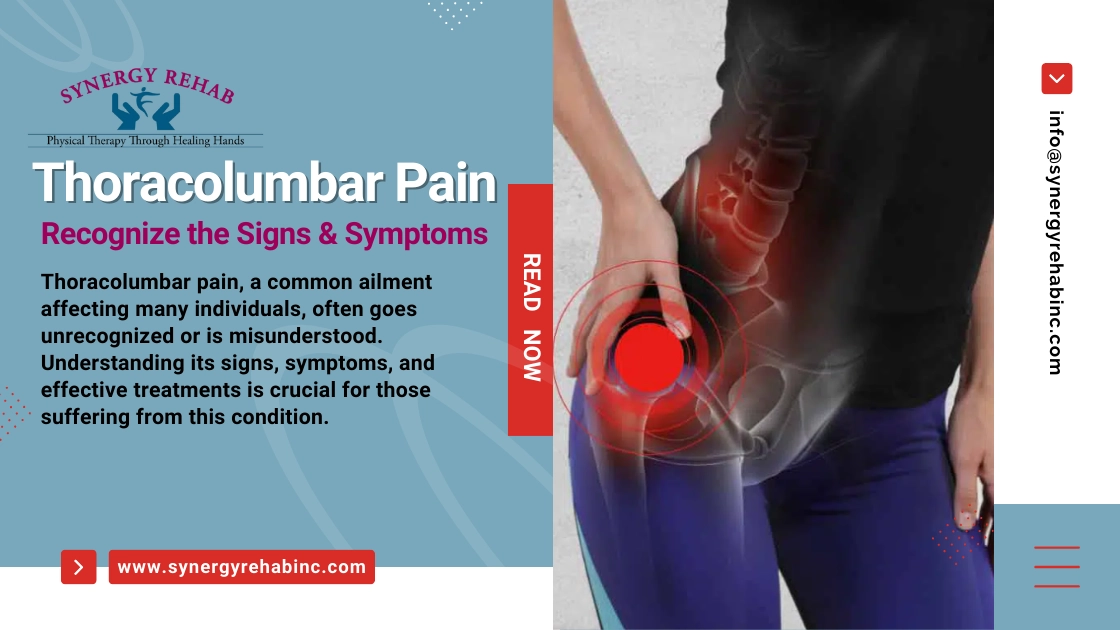Thoracolumbar Pain: Recognize the Signs & Symptoms
Thoracolumbar pain, a common ailment affecting many individuals, often goes unrecognized or is misunderstood. Understanding its signs, symptoms, and effective treatments is crucial for those suffering from this condition. This comprehensive guide aims to shed light on thoracolumbar pain, helping you identify and address it effectively. What is Thoracolumbar Fascia Pain? The thoracolumbar fascia is a vital component of the body’s musculoskeletal system, located in the lower back region. It is composed of connective tissue and extends across the lower part of the spine, covering the thoracic and lumbar areas. This fascia plays a crucial role in various bodily functions: Image Source: Physioroom Given its extensive use and importance in daily activities like bending, twisting, and lifting, the thoracolumbar fascia is highly susceptible to overuse and strain. This can lead to inflammation, stiffness, and pain in the area, known as thoracolumbar fascia pain. This condition can significantly impact mobility and quality of life, necessitating proper care and treatment. Recognizing the Signs and Symptoms Recognizing the signs and symptoms of thoracolumbar fascia pain is essential for timely and effective treatment. Key symptoms include: Effective Treatments for Thoracolumbar Pain Physical Therapy and Rehabilitation Image Source: Physiopedia Effective treatment of thoracolumbar pain often involves a multifaceted approach, with physical therapy and rehabilitation playing a central role. Here’s a more detailed look into how these treatments work: These therapies are tailored to individual needs and are often more effective when combined, addressing not just the symptoms but also the underlying causes of thoracolumbar pain. Core Stability Exercises specifically target the muscles in the trunk and lower back, playing a vital role in maintaining proper posture and spinal alignment. By strengthening these deep muscles, core stability exercises help to stabilize the spine, reducing strain on the thoracolumbar fascia and thereby alleviating thoracolumbar pain. Image Source: MDPI Myofascial Release Techniques, on the other hand, involve applying gentle, sustained pressure to the myofascial connective tissue to eliminate pain and restore motion. This method is particularly effective in treating issues related to fascial adhesions – areas where the fascia has become stiff or stuck, causing pain and restricting movement. When combined, core stabilization exercises and myofascial release techniques offer a comprehensive approach to treating lower back pain, especially in older adults. This combination not only helps in pain relief but also in improving the functional status of the back, making it a highly effective regimen for managing thoracolumbar pain. Lifestyle Adjustments for Managing Thoracolumbar Pain In addition to medical treatments, certain lifestyle adjustments can significantly alleviate thoracolumbar pain: Conclusion Thoracolumbar pain, though common, requires proper understanding and management. By recognizing its symptoms and seeking appropriate treatments, including physical therapy and lifestyle adjustments, individuals can effectively manage and alleviate this discomfort. Remember, early recognition and intervention are key to preventing the progression of thoracolumbar pain. If you’re struggling with thoracolumbar pain and seeking effective, personalized care, Synergy Rehab Inc. in Southfield is here to help. Our expert team specializes in physical therapy, core stability exercises, and myofascial release techniques tailored to your unique needs. Don’t let back pain hold you back any longer. Contact us today to start your journey toward pain relief and a healthier, more active lifestyle. Let us be your partner in managing and overcoming thoracolumbar pain. Call or visit our website to schedule your appointment with Synergy Rehab Inc. – your first step towards lasting back pain relief.



